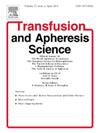戊型肝炎病毒在无症状献血者中的基因型分布及其对输血安全的影响
IF 1.2
4区 医学
Q4 HEMATOLOGY
引用次数: 0
摘要
戊型肝炎病毒是一种新出现的引起公共卫生关注的输血传播传染病。了解主要基因型对于实施筛选技术和理解病毒动力学至关重要。因此,本研究旨在调查无症状献血者中是否存在可检测的HEV- rna,以确定流行的HEV基因型。采用实时RT-PCR技术对无症状自愿献血者的血清HEV IgM反应样本进行HEV RNA筛查。此外,还进行了改良的Sanger测序和系统发育分析,以确定流行基因型。在27例血清反应样本中,2例(7 %)可检测到病毒血症,Ct值高。序列分析证实两份HEV rna阳性样本均为基因1型,这是印度唯一的人类感染基因型。现有文献报道,印度献血者的HEV血清阳性率高达60% %,1864份献血者中约有1份检测到HEV RNA。输血传播型HEV (TT-HEV)可通过血液单位筛查有效预防。估计不同地区戊型肝炎疾病负担并确定献血者和高危人群中的流行基因型对于指导有效实施戊型肝炎筛查政策至关重要。本文章由计算机程序翻译,如有差异,请以英文原文为准。
Genotypic distribution of hepatitis E virus among asymptomatic blood donors and its impact on transfusion safety
Hepatitis E virus is an emerging transfusion transmissible infectious disease of public health concern. Understanding the predominant genotype is crucial for implementing screening techniques and comprehending viral dynamics. Therefore, this study was conducted to investigate the presence of detectable HEV-RNA among the asymptomatic blood donors to identify the prevalent HEV genotype. Serologically HEV IgM reactive samples from asymptomatic voluntary blood donors were screened for HEV RNA using real-time RT-PCR. Additionally, modified Sanger sequencing and phylogenetic analysis were conducted to determine the prevalent genotype. Of the 27 seroreactive samples, two (7 %) had detectable viremia with a high Ct value. Sequence analysis confirmed both HEV RNA-positive samples as genotype 1, the only human-infecting genotype in India. Existing literature reports HEV seroprevalence among Indian blood donors as high as 60 %, with HEV RNA detected in approximately 1 in 1864 donations. Transfusion-transmitted HEV (TT-HEV) can be effectively prevented through blood unit screening. Estimating the Hepatitis E disease burden across different regions and identifying prevalent genotypes among blood donors and at-risk populations are crucial for guiding the effective implementation of an HEV screening policy.
求助全文
通过发布文献求助,成功后即可免费获取论文全文。
去求助
来源期刊
CiteScore
3.60
自引率
5.30%
发文量
181
审稿时长
42 days
期刊介绍:
Transfusion and Apheresis Science brings comprehensive and up-to-date information to physicians and health care professionals involved in the rapidly changing fields of transfusion medicine, hemostasis and apheresis. The journal presents original articles relating to scientific and clinical studies in the areas of immunohematology, transfusion practice, bleeding and thrombotic disorders and both therapeutic and donor apheresis including hematopoietic stem cells. Topics covered include the collection and processing of blood, compatibility testing and guidelines for the use of blood products, as well as screening for and transmission of blood-borne diseases. All areas of apheresis - therapeutic and collection - are also addressed. We would like to specifically encourage allied health professionals in this area to submit manuscripts that relate to improved patient and donor care, technical aspects and educational issues.
Transfusion and Apheresis Science features a "Theme" section which includes, in each issue, a group of papers designed to review a specific topic of current importance in transfusion and hemostasis for the discussion of topical issues specific to apheresis and focuses on the operators'' viewpoint. Another section is "What''s Happening" which provides informal reporting of activities in the field. In addition, brief case reports and Letters to the Editor, as well as reviews of meetings and events of general interest, and a listing of recent patents make the journal a complete source of information for practitioners of transfusion, hemostasis and apheresis science. Immediate dissemination of important information is ensured by the commitment of Transfusion and Apheresis Science to rapid publication of both symposia and submitted papers.

 求助内容:
求助内容: 应助结果提醒方式:
应助结果提醒方式:


